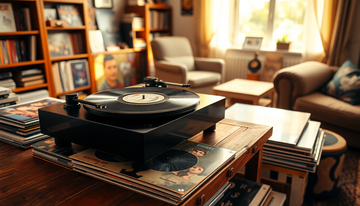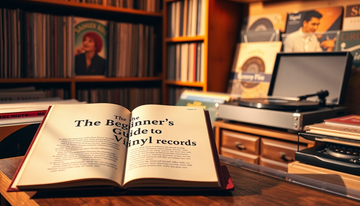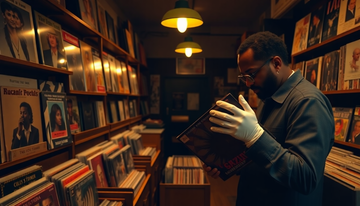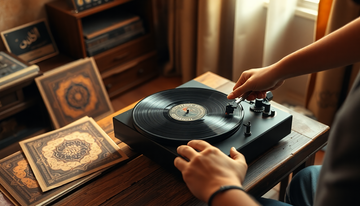In the ever-evolving landscape of music consumption, vinyl records have experienced a remarkable resurgence in recent years. As the world becomes increasingly digitized, music enthusiasts have found themselves drawn to the warm, distinctive crackle that emanates from the grooves of these analog marvels. The allure of vinyl is not just about the music itself, but the entire experience – the ritual of carefully placing the record on the turntable, the anticipation of the first notes, and the captivating crackle that accompanies each spin.
The Science Behind Vinyl Crackle
To understand the source of this captivating crackle, we must delve into the science behind vinyl records. These discs are made of a polyvinyl chloride (PVC) compound, with a series of microscopic grooves etched into the surface. As the stylus (or needle) of the turntable gently glides through these grooves, it picks up the vibrations and translates them into the music we hear. However, it's the imperfections within these grooves that give rise to the characteristic crackle.
The crackle is a result of the stylus encountering tiny imperfections, dust particles, and microscopic scratches on the record's surface. As the stylus navigates these irregularities, it creates subtle disturbances in the audio signal, producing the familiar crackle that has become synonymous with the vinyl experience. This interplay between the stylus and the record's surface is what gives vinyl its distinctive sonic signature, a quality that many music enthusiasts find captivating.
Common Causes of Vinyl Crackle
While the crackle is an integral part of the vinyl experience, it can also be a source of frustration for some listeners. There are several common causes of this unwanted noise, including:
-
Dust and debris: Over time, dust and other particles can accumulate on the record's surface, interfering with the stylus's smooth movement and creating unwanted crackles.
-
Wear and tear: Repeated playback can gradually wear down the record's grooves, leading to increased crackle and even permanent damage to the disc.
-
Static electricity: The friction between the stylus and the record can generate static electricity, which can attract dust and other particles, further exacerbating the crackle.
-
Manufacturing imperfections: In some cases, the crackle may be the result of minor flaws in the record's manufacturing process, such as uneven pressing or inconsistencies in the PVC compound.
The Debate: Charm vs. Imperfection
The debate surrounding the crackle of vinyl records is a fascinating one, with passionate arguments on both sides. For many music enthusiasts, the crackle is an integral part of the vinyl experience, adding a sense of warmth and nostalgia to the listening process. They argue that the imperfections inherent in vinyl records contribute to the overall charm and character of the medium, creating a more authentic and immersive listening experience.
On the other hand, audiophiles and purists often view the crackle as an unwanted distraction, a blemish on the purity of the music. They contend that the crackle detracts from the overall sound quality, compromising the listener's ability to fully immerse themselves in the music. These individuals often seek out the cleanest, most pristine vinyl pressings, or even turn to digital formats in the pursuit of a flawless listening experience.
Minimizing Vinyl Crackle
For those who wish to enjoy the warmth of vinyl while minimizing the crackle, there are several strategies to consider. Proper cleaning techniques, such as using a specialized record cleaning solution and a microfiber cloth, can help remove dust and debris from the record's surface, reducing the potential for crackle. Additionally, careful handling and storage of vinyl records, keeping them in protective sleeves and away from direct sunlight, can help preserve the integrity of the grooves and minimize wear and tear over time.
Anti-static tools, such as carbon fiber brushes and record cleaning machines, can also be effective in reducing the buildup of static electricity, which can contribute to the crackle. By addressing these common causes of vinyl crackle, music enthusiasts can enjoy the warm, analog sound of vinyl while minimizing the unwanted noise.
The Role of Equipment
The quality of the turntable and stylus also plays a significant role in the overall crackle factor. Higher-end turntables, equipped with precision-engineered components and advanced anti-vibration technology, can help to reduce the impact of imperfections on the record's surface, resulting in a cleaner, more refined sound. Similarly, the condition of the stylus is crucial, as a worn or damaged stylus can exacerbate the crackle and even cause further damage to the record's grooves.
Digital vs. Vinyl: The Crackle Factor
In the ongoing debate between digital and analog formats, the crackle factor is often a key point of contention. While digital formats, such as CDs and streaming services, offer a pristine, noise-free listening experience, some music enthusiasts argue that the absence of crackle robs the music of its warmth and character. They contend that the subtle imperfections inherent in vinyl records contribute to a more authentic and immersive listening experience, one that digital formats simply cannot replicate.
Conclusion
The crackle of vinyl records has become an integral part of the vinyl experience, a captivating and nostalgic element that has endeared the format to music enthusiasts around the world. While the debate surrounding the charm versus the imperfection of this crackle continues, it is undeniable that the unique sonic signature of vinyl records has played a significant role in their resurgence in the digital age.
By understanding the science behind the crackle, exploring the common causes, and embracing the various strategies for minimizing its impact, music lovers can fully immerse themselves in the warm, analog sound of vinyl, celebrating the imperfections that make the format so alluring. Whether you're a seasoned collector or just embarking on your vinyl journey, the crackle of a well-loved record is a testament to the enduring appeal of this timeless medium.






